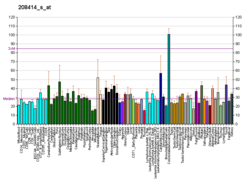HOXB3
Homeobox protein Hox-B3 is a protein that in humans is encoded by the HOXB3 gene.[5][6][7]
This gene is a member of the Antp homeobox family and encodes a nuclear protein with a homeobox DNA-binding domain. It is included in a cluster of homeobox B genes located on chromosome 17. The encoded protein functions as a sequence-specific transcription factor that is involved in development. Increased expression of this gene is associated with a distinct biologic subset of acute myeloid leukemia (AML).[7]
See also
References
- 1 2 3 GRCh38: Ensembl release 89: ENSG00000120093 - Ensembl, May 2017
- 1 2 3 GRCm38: Ensembl release 89: ENSMUSG00000048763 - Ensembl, May 2017
- ↑ "Human PubMed Reference:".
- ↑ "Mouse PubMed Reference:".
- ↑ McAlpine PJ, Shows TB (Aug 1990). "Nomenclature for human homeobox genes". Genomics. 7 (3): 460. doi:10.1016/0888-7543(90)90186-X. PMID 1973146.
- ↑ Scott MP (Dec 1992). "Vertebrate homeobox gene nomenclature". Cell. 71 (4): 551–3. doi:10.1016/0092-8674(92)90588-4. PMID 1358459.
- 1 2 "Entrez Gene: HOXB3 homeobox B3".
Further reading
- Giampaolo A, Acampora D, Zappavigna V, et al. (1989). "Differential expression of human HOX-2 genes along the anterior-posterior axis in embryonic central nervous system". Differentiation. 40 (3): 191–7. doi:10.1111/j.1432-0436.1989.tb00598.x. PMID 2570724.
- Acampora D, D'Esposito M, Faiella A, et al. (1990). "The human HOX gene family". Nucleic Acids Res. 17 (24): 10385–402. doi:10.1093/nar/17.24.10385. PMC 335308. PMID 2574852.
- Boncinelli E, Acampora D, Pannese M, et al. (1990). "Organization of human class I homeobox genes". Genome. 31 (2): 745–56. doi:10.1139/g89-133. PMID 2576652.
- Guazzi S, Lonigro R, Pintonello L, et al. (1994). "The thyroid transcription factor-1 gene is a candidate target for regulation by Hox proteins". EMBO J. 13 (14): 3339–47. PMC 395231. PMID 7913891.
- Apiou F, Flagiello D, Cillo C, et al. (1996). "Fine mapping of human HOX gene clusters". Cytogenet. Cell Genet. 73 (1–2): 114–5. doi:10.1159/000134320. PMID 8646877.
- Bingle CD, Gowan S (1996). "Oct-1 interacts with conserved motifs in the human thyroid transcription factor 1 gene minimal promoter". Biochem. J. 319 ( Pt 3) (Pt 3): 669–74. PMC 1217841. PMID 8920965.
- Sauvageau G, Thorsteinsdottir U, Hough MR, et al. (1997). "Overexpression of HOXB3 in hematopoietic cells causes defective lymphoid development and progressive myeloproliferation". Immunity. 6 (1): 13–22. doi:10.1016/S1074-7613(00)80238-1. PMID 9052833.
- Guazzi S, Pintonello ML, Viganò A, Boncinelli E (1998). "Regulatory interactions between the human HOXB1, HOXB2, and HOXB3 proteins and the upstream sequence of the Otx2 gene in embryonal carcinoma cells". J. Biol. Chem. 273 (18): 11092–9. doi:10.1074/jbc.273.18.11092. PMID 9556594.
- Viganò MA, Di Rocco G, Zappavigna V, Mavilio F (1998). "Definition of the Transcriptional Activation Domains of Three Human HOX Proteins Depends on the DNA-Binding Context". Mol. Cell. Biol. 18 (11): 6201–12. PMC 109207. PMID 9774637.
- Kosaki K, Kosaki R, Suzuki T, et al. (2002). "Complete mutation analysis panel of the 39 human HOX genes". Teratology. 65 (2): 50–62. doi:10.1002/tera.10009. PMID 11857506.
- Nakamura N, Yoshimi T, Miura T (2002). "Increased gene expression of lung marker proteins in the homeobox B3-overexpressed fetal lung cell line M3E3/C3". Cell Growth Differ. 13 (4): 195–203. PMID 11971819.
- Ota T, Suzuki Y, Nishikawa T, et al. (2004). "Complete sequencing and characterization of 21,243 full-length human cDNAs". Nat. Genet. 36 (1): 40–5. doi:10.1038/ng1285. PMID 14702039.
- Pineault N, Abramovich C, Ohta H, Humphries RK (2004). "Differential and Common Leukemogenic Potentials of Multiple NUP98-Hox Fusion Proteins Alone or with Meis1". Mol. Cell. Biol. 24 (5): 1907–17. doi:10.1128/MCB.24.5.1907-1917.2004. PMC 350554. PMID 14966272.
- Roche J, Zeng C, Barón A, et al. (2004). "Hox expression in AML identifies a distinct subset of patients with intermediate cytogenetics". Leukemia. 18 (6): 1059–63. doi:10.1038/sj.leu.2403366. PMID 15085154.
- Brandenberger R, Wei H, Zhang S, et al. (2005). "Transcriptome characterization elucidates signaling networks that control human ES cell growth and differentiation". Nat. Biotechnol. 22 (6): 707–16. doi:10.1038/nbt971. PMID 15146197.
- Speleman F, Cauwelier B, Dastugue N, et al. (2005). "A new recurrent inversion, inv(7)(p15q34), leads to transcriptional activation of HOXA10 and HOXA11 in a subset of T-cell acute lymphoblastic leukemias". Leukemia. 19 (3): 358–66. doi:10.1038/sj.leu.2403657. PMID 15674412.
- Kimura K, Wakamatsu A, Suzuki Y, et al. (2006). "Diversification of transcriptional modulation: Large-scale identification and characterization of putative alternative promoters of human genes". Genome Res. 16 (1): 55–65. doi:10.1101/gr.4039406. PMC 1356129. PMID 16344560.
External links
- HOXB3+protein,+human at the US National Library of Medicine Medical Subject Headings (MeSH)
This article incorporates text from the United States National Library of Medicine, which is in the public domain.
This article is issued from
Wikipedia.
The text is licensed under Creative Commons - Attribution - Sharealike.
Additional terms may apply for the media files.




